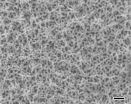Cobalt film a clean-fuel find
Rice University discovery is efficient, robust at drawing hydrogen and oxygen from water
2015-04-15
(Press-News.org) HOUSTON - (April 15, 2015) - A cobalt-based thin film serves double duty as a new catalyst that produces both hydrogen and oxygen from water to feed fuel cells, according to scientists at Rice University.
The inexpensive, highly porous material invented by the Rice lab of chemist James Tour may have advantages as a catalyst for the production of hydrogen via water electrolysis. A single film far thinner than a hair can be used as both the anode and cathode in an electrolysis device.
The researchers led by Rice postdoctoral researcher Yang Yang reported their discovery today in Advanced Materials.
They determined their cobalt film is much better at producing hydrogen than most state-of-the-art materials and is competitive with (and much cheaper than) commercial platinum catalysts. They reported the catalyst also produced an oxygen evolution reaction comparable to current materials.
"It is amazing that in water-splitting, the same material can make both hydrogen and oxygen," Tour said. "Usually materials make one or the other, but not both."
The researchers suggested applying alternating current from wind or solar energy sources to cobalt-based electrolysis could be an environmentally friendly source of hydrogen and oxygen.
"Here we can just alternate the current from positive to negative and back again, and hydrogen and oxygen are made with the same material," Tour said. "And the material itself is very easy to make." He said manufacturing the film is inexpensive and scalable.
The lab fabricated the 500-nanometer films by anodyzing a cobalt film electrodeposited on a substrate. The assembly was then baked for two hours in a phosphorus vapor that converted it to a cobalt/phosphide/phosphate thin film without damaging its porous structure.
The material proved to be robust in both durability tests and in acidic and alkaline conditions, Tour said.
INFORMATION:
Graduate students Huilong Fei and Gedeng Ruan are co-authors of the paper.
Tour is the T.T. and W.F. Chao Chair in Chemistry as well as a professor of materials science and nanoengineering and of computer science and a member of Rice's Richard E. Smalley Institute for Nanoscale Science and Technology.
The Air Force Office of Scientific Research and its Multidisciplinary University Research Initiative supported the research.
Read the abstract at http://onlinelibrary.wiley.com/doi/10.1002/adma.201500894/abstract
This news release can be found online at http://news.rice.edu/2015/04/15/cobalt-film-a-clean-fuel-find/
Follow Rice News and Media Relations via Twitter @RiceUNews
Related Materials:
Tour Group: http://www.jmtour.com
Wiess School of Natural Sciences: http://naturalsciences.rice.edu
Images for download:
http://news.rice.edu/wp-content/uploads/2015/04/0413_CATALYST-1-web.jpg
A porous cobalt phosphide/phosphate thin film created at Rice University has the ability to serve as both an anode and cathode in a water-electrolysis device. The robust film can produce both hydrogen and oxygen from water to feed fuel cells. The scale bar equals 500 nanometers. (Credit: Tour Group/Rice University)
http://news.rice.edu/wp-content/uploads/2015/04/0413_CATALYST-2-web.jpg
(WITH LABELS)
A side view of a porous cobalt phosphide/phosphate thin film created at Rice University. The robust film could replace expensive metals like platinum in water-electrolysis devices that produce hydrogen and oxygen for fuel cells. The scale bar equals 500 nanometers. (Credit: Tour Group/Rice University)
http://news.rice.edu/wp-content/uploads/2015/04/0413_CATALYST-3-web.jpg
(NO LABELS)
A side view of a porous cobalt phosphide/phosphate thin film created at Rice University. The robust film could replace expensive metals like platinum in water-electrolysis devices that produce hydrogen and oxygen for fuel cells. The scale bar equals 500 nanometers. (Credit: Tour Group/Rice University)
ELSE PRESS RELEASES FROM THIS DATE:
2015-04-15
The slow implementation of the Chemical Facility Anti-Terrorism Standards (CFATS) in the USA as part of homeland security and anti-terrorism measures is leaving chemical plants vulnerable and putting at risk the safety of American citizens, according to research published in the International Journal of Critical Infrastructures.
Maria Rooijakkers and Abdul-Akeem Sadiq of the School of Public and Environmental Affairs, at Indiana University-Purdue University, in Indianapolis, explain that post-9/11 efforts to safeguard the chemical sector gave the Department of Homeland ...
2015-04-15
WASHINGTON -- U.S. communities and federal agencies should more intentionally seek to create healthier communities during disaster preparation and recovery efforts - something that rarely happens now, says a new report from the Institute of Medicine. By adding a health "lens" to planning and recovery, a community can both mitigate the health damage caused by disasters and recover in ways that make the community healthier and more resilient than it was before.
"We have an opportunity to transform our response to devastating disasters into an effort to meaningfully enhance ...
2015-04-15
MIT chemists have devised an inexpensive, portable sensor that can detect gases emitted by rotting meat, allowing consumers to determine whether the meat in their grocery store or refrigerator is safe to eat.
The sensor, which consists of chemically modified carbon nanotubes, could be deployed in "smart packaging" that would offer much more accurate safety information than the expiration date on the package, says Timothy Swager, the John D. MacArthur Professor of Chemistry at MIT.
It could also cut down on food waste, he adds. "People are constantly throwing things ...
2015-04-15
Young offenders in late Victorian times were much less likely to go on to commit other crimes after serving a sentence in an institution than their counterparts today, new research shows.
A study of the lives of 500 children committed to reformatory or industrial schools over a century ago showed that only 22% re-offended during the rest of their lives after their release. This compares with today's figure of 73% of young people re-offending within a year after release from custody.
Professor Pamela Cox told the British Sociological Association's annual conference ...
2015-04-15
LAWRENCE -- Most partisans -- average Democratic and Republican voters -- act like fans in sports rivalries instead of making political choices based on issues, according to a new study with a University of Kansas researcher as the lead author.
"What is the consequence of today's polarized politics? What's motivating partisans to vote in this climate?" said Patrick Miller, a University of Kansas assistant professor of political science. "For too many of them, it's not high-minded, good-government, issue-based goals. It's, 'I hate the other party. I'm going to go out, ...
2015-04-15
FAYETTEVILLE, AR - Determining and implementing orchard management practices that can improve soil organic matter is one of the primary goals of the USDA's National Organic Program. For producers in the southeastern United States, where interest in small-scale and organically managed orchards is growing, the challenge can be finding combinations of groundcover management systems and organic nutrient sources that can simultaneously improve soil quality. A new research study provides producers in the region with valuable information about effective organic orchard management ...
2015-04-15
It's not all bad for crow chicks who have to share their nest with an uninvited pushy guest such as a cuckoo youngster. For one, they can sit back and wait for food to arrive while the cuckoo chick does all the begging for nourishment. So says Diana Bolopo of the University of Valladolid in Spain, who led a study into the pros and cons associated with the parasitic relationship of the great spotted cuckoo with the carrion crow. The findings are published in Springer's journal Behavioral Ecology and Sociobiology.
When great spotted cuckoos parasitize and take over magpie ...
2015-04-15
This news release is available in German.
Modern, machine-friendly agriculture is dominated by monocultures. One single cultivar - one genotype of a crop species - is cultivated on large areas. Favored cultivars are optimized for high yields and often contain only few natural plant defense compounds. Unfortunately, these extensive monocultures of identical plants can become an ecological wasteland and cause permanent damage to the ecosystem, especially when combined with blanket application of fertilizer and pesticides. Scientists at the Max Planck Institute ...
2015-04-15
Researchers from North Carolina State University and the University of Colorado, Boulder, have developed a statistical model that allows them to tell where a dust sample came from within the continental United States based on the DNA of fungi found in the sample.
The primary goal of the research was to develop a new forensic biology tool for law enforcement or archaeologists. "But it may also give us a greater understanding of the invisible ecosystems of microbial life that we know are all around us, but that we don't fully comprehend," says Neal Grantham, a Ph.D. student ...
2015-04-15
Adults who have ADHD are much more likely to report they were sexually and physically abused before they turned 16 than their peers without ADHD, according to a new study from researchers at the University of Toronto.
Among women, 34 per cent of those with ADHD reported they were sexually abused before they turned 18. In contrast, 14 per cent of women without ADHD reported that they had experienced childhood sexual abuse. Twice as many women with ADHD reported that they had experienced childhood physical abuse than women without this condition (44% vs 21%).
"These ...
LAST 30 PRESS RELEASES:
[Press-News.org] Cobalt film a clean-fuel find
Rice University discovery is efficient, robust at drawing hydrogen and oxygen from water




